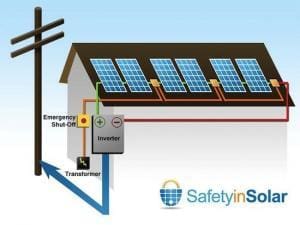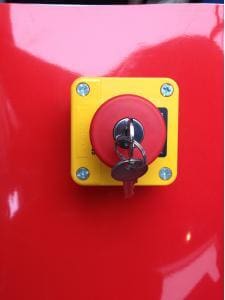As with any industry, there are certain minimum standards that a solar system and its comprising components must meet in order to be installed to be considered safe. SafetyinSolar’s Solar Panel Isolation System adds an extra level of protection, especially for homes located in regions that are prone to bush-fires or flooding, by enabling an entire solar panel array to be essentially ‘switched off’ from a centralised location and rendered harmless.
The Issue: Absence of panel isolation mechanisms in solar PV systems
The electricity produced by solar panels is DC (direct current) electricity, which must be converted into AC (alternating current) electricity in order to be used by most appliances and in order to be exported to the electricity grid. In most solar PV systems, DC electricity is converted to AC electricity via a centralised inverter, which is usually located some distance from the panels themselves.
The cabling that runs between the inverter and the solar panel array carries DC electricity. DC electricity is significantly more dangerous than AC electricity for a number of reasons–high voltage DC power can be lethal, and is prone to ‘arcing‘, in which electricity literally leaps through the air when there is a fault in circuitry. This is a well-recognised danger, and measures to mitigate it are built into the current Australian-NZ standard for solar PV system installations.
An issue arises however, in the event of fire at a home or business with a solar PV system. One of the first things that a rescue crew will do in the event of such an emergency is terminate power from the electricity grid to ensure that no electricity is flowing through the building in question. A solar system, however, continues to produce power for as long as the sun is shining, and in most cases there is no way to stop this or reduce the voltage to a safe level. Consequently, in the event that no one is in the building, recue crews may make a decision to allow the fire to burn itself out rather than risk electrocution. In addition to rescue crews, this is also clearly a concern for the property owner as well as insurance companies.
Building fires and floods are the most likely instance of the potential danger arising from the presence of long lengths of DC cabling, but homes or businesses may want to be able to ‘turn off’ their solar array during daylight hours for a number of other reasons as well: to undertake roof maintenance, cleaning and repairs, to preemptively minimise danger in the case of an oncoming bush fire, or to access the roof to retrieve lost balls or fugitive pets.
The Solution: Lowering solar panel output to ‘extra low-voltage’ levels via a central switch
With the number of solar PV installations growing significantly in recent years and expected to grow further into the future, ways to improve safety will be of increasing interest to system owners, governments, insurers, and solar industry bodies. In anticipation of this, and in response to safety matters that arose during the 2011 Brisbane floods, SafetyinSolar has developed a ‘Solar Isolation System’ by which solar panels can effectively be ‘shut off’ to effectively remove potential electrocution and fire hazards associated with solar panels.
The system removes the danger usually associated with ‘live’ solar panels by inserting isolator boxes between each set of 2 panels in a ‘string’ and, when activated, knocking back the power produced to that of the first 2 panels in the array. Although these panels will still produce power after activation, the voltage will be reduced to what is considered to be ‘extra low voltage’ as per section 1.4.98 of the AS/NZ 3000 standard for wiring rules, and therefore safe in the event of fire or flood.
There are 3 ways that the the SafetyinSolar isolation mechanism is activated.
1. When fire crews disconnect the fuse at the head black mains on the street level, the solar isolation system is automatically activated.
2. For homes with underground power lines and for an additional level of control, a safety control knob can be installed besides or above the electricity meter box. This allows building owners or fire crews to activate and disable the safety mechanism themselves as necessary with a key.
3. The safety mechanism is automatically activated if roof temperature reaches 100 degrees C (as in the case of a bush fire).
SafetyinSolar’s system can be retrofitted to existing solar systems or installed along with a new one. Indicative installation costs are approximately $1,900 for a 10-kilowatt (kW) system, around $1,000 for a 5kW system, or $550 for a 2kW system.
SafetyinSolar Solar Isolation System: Isolation boxes are inserted between every 2 panels. (Click to enlarge. Image via SafetyinSolar.)
SafetyinSolar manual activation knob. (Click to enlarge. Image via SafetyinSolar.)
© 2012 Solar Choice Pty Ltd
- Solar Power Wagga Wagga, NSW – Compare outputs, returns and installers - 13 March, 2025
- Monocrystalline vs Polycrystalline Solar Panels: Busting Myths - 11 November, 2024
- Solar Hot Water System: Everything You Need to Know - 27 February, 2024

